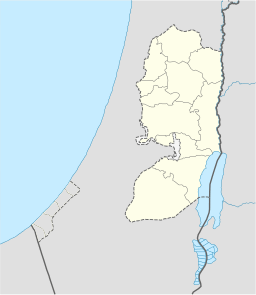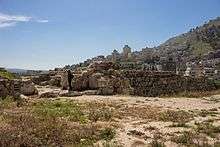Tell Balata
Tell Balata (Arabic: تل بلاطة) is the site of the remains of an ancient Canaanite/Israelite[1] city located in the Palestinian West Bank.[2] The built-up area of Balata, a Palestinian village and suburb of Nablus, covers about one-third of the tell, and overlooks a vast plain to the east.[3][4] The Palestinian village of Salim (biblical Salem) is located 4.5 kilometers (2.8 mi) to the east.[5]
تل بلاطة | |
. | |
 Shown within the West Bank | |
| Location | |
|---|---|
| Coordinates | 32.213618°N 35.281993°E |
| History | |
| Associated with | Canaanite, Israelite, Samaritan, Hellenistic |
The site is listed by UNESCO as part of the Inventory of Cultural and Natural Heritage Sites of Potential Outstanding Universal Value in the Palestinian Territories.[2] Experts estimate that the towers and buildings at the site date back 5,000 years to the Chalcolithic and Bronze Ages.[2]
Modern name
Tell is an old Semitic word for an archaeological mound, long used by Arabs.[6] Balata is the name of the ancient Arab village located on the tell, and of the adjacent Palestinian refugee camp of Balata established in 1950.[7] The name was preserved by local residents and used to refer both to the village and the hill (and later on, the refugee camp).[8]
One theory holds that balata is a derivation of the Aramaic word Balut, meaning acorn; another theory holds that it is a derivation of the Byzantine-Roman era, from the Greek word platanos, meaning terebinth, a type of tree that grew around the spring of Balata.[7][8] The local Samaritan community traditionally called the site 'The Holy Oak' or 'The Tree of Grace'.[9]
Identification as ancient Shechem
Traditionally, the site has been associated with biblical Samaritan city of Shechem said by Josephus to have been destroyed by John Hyrcanus I, based on circumstantial evidence such as its location and preliminary evidence of habitation during the late Bronze and early Iron Ages. Tell Balata lies in a mountain pass between Mount Gerizim and Mount Ebal, a location that fits well with the geographical description provided for Shechem in the Bible.[10] No inscriptional evidence to support this conclusion has been found in situ, and other sites have also been identified as the possible site of biblical Shechem; for example, Y. Magen locates that city nearby, on Mount Gerizim at a site covering an area of 30 hectares.[11]
Archaeology

The site was first excavated by a German team led by Ernst Sellin from 1913 to 1914. After the end of World War I, work by Sellin was resumed in 1926 and lasted until 1934 with the last few seasons led by G. Welter. [12] [13] [14] [15]
Excavations were conducted at Tell Balata by the American Schools of Oriental Research, Drew University, and the McCormick Theological Seminary in 8 seasons between 1956 and 1964 when the West Bank was under the rule of Jordan. [16] [17] [18] [19] [20] [21] [22] Archaeologists who took part in this expedition included Paul and Nancy Lapp, Albert Glock, Lawrence Toombs, Edward Campbell, Robert Bull, Joe Seeger, and William G. Dever, among others.[23] Further excavations are to be undertaken by Palestinian archaeologists along with students from the University of Leiden in the Netherlands as part of a joint effort funded by the Dutch government.[2]
A 2002 final published report on the stratigraphic and architectural evidence at Tell Balata indicates that there was a break in occupation between the end of the Late Bronze Age (c. 1150 BC) through to the early Iron Age II (c. 975 BC).[24] A small quadrangular altar discovered in Tell Balata, similar to ones found in other Iron Age sites such as Tel Arad and Tel Dan, may have been used for burning incense.[25]
One of the oldest coins discovered in Palestine was an electrum Greek Macedonian coin, dated to circa 500 BC, found at Tell Balata.[26] There is evidence that the site was inhabited in the Hellenistic period until the end of the 2nd century BC.[27] This Hellenistic era city was founded in the late 4th century BC and extended over an area of 6 hectares. The built structure shows evidence of considerable damage dated to the 190s BC, and attributed to Antiochus III's conquest of Israel. Habitation continued until the final destruction of the city at this site in the late 2nd century BC.
References
- Excavations done at former Israelite capital Shechem
- Haaretz service and Cnaan Liphshiz (March 2, 2010). "Palestinian archeology gets int'l boost ahead of 2011 statehood plan". Haaretz. Retrieved January 13, 2018.
- "Tell Balata". Visitpalestine.ps. Retrieved 2010-03-07.
- Pfeiffer, 1966, p. 518.
- Kalai, 2000, p. 114.
- Archaeology of Palestine, Art of Excavating a Palestinian Mound, William Foxwell Albright, 1960, p. 16
- Crown et al., 1993, p. 39.
- Mazar and Ahituv, 1992, p. 53.
- Cunningham Geike, The Holy Land and the Bible: a book of Scripture illustrations gathered in Palestine, Cassell, London 1887 p.211.
- Rast, 1992, p. 31.
- Shatzman, 1991, p. 60.
- Ernst Sellin, Die Ausgrabungen von Sichem. Kurze vorlaufige Mitteilung uber die Arbeit im Fruhjahr 1926, Zeitschrift des Deutschen Palästina-Vereins, vol 49, pp. 229-236, pls. 26-31, 1926
- Ernst Sellin, Die Ausgrabungen von Sichem. Kurze vorlaufige Mitteilung uber die Arbeit im Sommer 1926, ZDPV, vol 49, pp. 304-320, pls. 32-46, 1926
- Ernst Sellin, Die Ausgrabungen von Sichem. Kurze vorlaufige Mitteilung uber die Arbeit im Fruhjahr 1927, ZDPV, vol 50, pp. 205-211, pls. 11-18, 1927
- Ernst Sellin, Die Ausgrabungen von Sichem. Kurze vorlaufige Mitteilung uber die Arbeit im Sommer 1927, ZDPV, vol 50, pp. 265-274, pls. 22-30, 1927
- G. Ernest Wright, The First Campaign at Tell Balâtah (Shechem), Bulletin of the American Schools of Oriental Research, no. 144, pp. 9-20, 1956
- G. Ernest Wright, The Second Campaign at Tell Balâtah (Shechem), Bulletin of the American Schools of Oriental Research, no. 148, pp. 11-28, 1957
- Lawrence E. Toombs et al., The Third Campaign at Balâtah (Shechem), Bulletin of the American Schools of Oriental Research, no. 161, pp. 11-54, 1961
- Lawrence E. Toombs et al., The Fourth Campaign at Balâtah (Shechem), Bulletin of the American Schools of Oriental Research, no. 169, pp. 1-60, 1963
- Robert J. Bull et. el., The Fifth Campaign at Balâtah (Shechem), Bulletin of the American Schools of Oriental Research, no. 180, pp. 7-41, 1965
- Robert J. Bull and Edward F. Campbell Jr., The Sixth Campaign at Balâtah (Shechem), Bulletin of the American Schools of Oriental Research, no. 190, pp. 2-41, 1968
- Edward F. Campbell Jr. et al., The Eighth Campaign at Balatah (Shechem), Bulletin of the American Schools of Oriental Research, no. 204, pp. 2-17+40, 1971
- Silberman in Meskell, 1998, p. 184.
- Edward F. Campbell, Shechem III: The Stratigraphy and Architecture of Shechem/Tell Balâtah. Vol. 1. Text. Vol. 2. The Illustrations, American Schools of Oriental Research, 2002, ISBN 978-0-89757-062-6
- Becking, 2001, p. 52.
- De Vaux, 1997, p. 208.
- Isaac, 1998, p. 16.
See also
- Cities of the ancient Near East
References
- Becking, Bob (2001). Bob Becking (ed.). Only one god?: monotheism in ancient Israel and the veneration of the goddess Asherah (Illustrated ed.). Continuum International Publishing Group. ISBN 9781841271996.
- Robert J. Bull, A Note on Theodotus' Description of Shechem, The Harvard Theological Review, vol. 60, no. 2, pp. 221–227, 1967
- Edward F. Campbell Jr, Shechem II: Portrait of a Hill Country Vale: The Shechem Regional Survey, American Schools of Oriental Research, 1991, ISBN 1-55540-639-4
- Dan P Cole, Shechem 1: The Middle Bronze IIB Pottery, Eisenbrauns, 1984, ISBN 0-89757-206-8
- Crown, Alan David; Pummer, Reinhard; Tal, Abraham (1993). Alan David Crown; Reinhard Pummer; Abraham Tal (eds.). A companion to Samaritan studies. Mohr Siebeck. ISBN 9783161456664.
- De Vaux, Roland (1997). Ancient Israel: its life and institutions. John McHugh (trans.). Wm. B. Eerdmans Publishing. ISBN 9780802842787.
- William G. Dever, The MB IIC Stratification in the Northwest Gate Area At Shechem, Bulletin of the American Schools of Oriental Research, no. 216, pp. 31–52, 1974
- Isaac, Benjamin H. (1998). The Near East under Roman rule: selected papers (Illustrated ed.). Brill. ISBN 9789004107366.
- Ḳalai, Zekharyah; Gālîl, Gēršôn; Weinfeld, Moshe, eds. (2000). Studies in historical geography and biblical historiography: presented to Zechariah Kallai (Illustrated ed.). Brill. ISBN 9789004116085.
- Killebrew, Ann E. (2005). Biblical peoples and ethnicity: an archaeological study of Egyptians, Canaanites, Philistines, and early Israel, 1300-1100 B.C.E (Illustrated ed.). Society of Biblical Literature. ISBN 9781589830974.
- Siegfried H. Horn, Scarabs and Scarab Impressions from Shechem-II, Journal of Near Eastern Studies, Vol. 25, No. 1, pp. 48–56, 1966
- Nancy L. Lapp, The Stratum V Pottery from Balâtah (Shechem), Bulletin of the American Schools of Oriental Research, no. 257, pp. 19–43, 1985
- Nancy Lapp, Shechem IV: The Persian-Hellenistic Pottery of Shechem/Tell Balatah, American Schools of Oriental Research, 2008, ISBN 978-0-89757-079-4
- Nancy R. Lapp, Pottery from Some Hellenistic Loci at Balâtah (Shechem), Bulletin of the American Schools of Oriental Research, no. 175, pp. 14–26, 1964
- Levy, Thomas (1998). Thomas Levy (ed.). The archaeology of society in the Holy Land (2nd, illustrated ed.). Continuum International Publishing Group. ISBN 9780826469960.
- Mazar, Benjamin; Aḥituv, Shmuel (1992). Shmuel Aḥituv (ed.). Biblical Israel: state and people (Illustrated ed.). Magnes Press, Hebrew University. ISBN 9789652237972.
- Pfeiffer, Charles F., ed. (1966). The Biblical world: a dictionary of Biblical archaeology (Illustrated ed.). Baker Book House. ISBN 9780801069154.
tell balata village.
- Rast, Walter E. (1992). Through the ages in Palestinian archaeology: An Introductory Handbook (Illustrated ed.). Continuum International Publishing Group. ISBN 9781563380556.
- Shatzman, Israel (1991). The armies of the Hasmonaeans and Herod: from Hellenistic to Roman frameworks. Mohr Siebeck. ISBN 9783161456176.
- Silberman, Neil Asher (1998). Lynn Meskell (ed.). Archaeology under fire: nationalism, politics and heritage in the Eastern Mediterranean and Middle East (Illustrated ed.). Routledge. ISBN 9780415196550.
- Lawrence E. Toombs, The Stratification of Tell Balâtah (Shechem), Bulletin of the American Schools of Oriental Research, no. 223, pp. 57–59, 1976
- David Ussishkin, Notes on the Fortifications of the Middle Bronze II Period at Jericho and Shechem, Bulletin of the American Schools of Oriental Research, no. 276, pp. 29–53, 1989
- G. Ernest Wright, Selected Seals from the Excavations at Balâtah (Shechem), Bulletin of the American Schools of Oriental Research, no. 167, pp. 5–13, 1962
- G. R. H. Wright, The Architectural Recording of the Shechem Excavation, The Biblical Archaeologist, vol. 23, no. 4, pp. 120–126, 1960